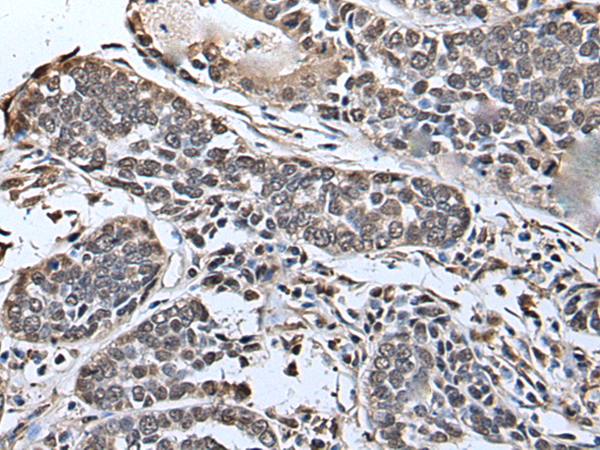
| WB | 咨询技术 | Human,Mouse,Rat |
| IF | 咨询技术 | Human,Mouse,Rat |
| IHC | 1/30-1/150 | Human,Mouse,Rat |
| ICC | 技术咨询 | Human,Mouse,Rat |
| FCM | 咨询技术 | Human,Mouse,Rat |
| Elisa | 1/5000-1/10000 | Human,Mouse,Rat |
| Aliases | LRRC11; bA364G4.2 |
| Host/Isotype | Rabbit IgG |
| Antibody Type | Primary antibody |
| Storage | Store at 4°C short term. Aliquot and store at -20°C long term. Avoid freeze/thaw cycles. |
| Species Reactivity | Human, Mouse |
| Immunogen | Fusion protein of human SLITRK5 |
| Formulation | Purified antibody in PBS with 0.05% sodium azide and 50% glycerol. |
+ +
以下是关于 **SLITRK5抗体** 的3篇参考文献及其简要摘要:
---
1. **文献名称**: *SLITRK5 Mediates Mechanical Itch via Modulation of Excitatory Synaptic Transmission*
**作者**: Feng J, Sun Y, Zhang Y, et al.
**摘要**: 该研究利用SLITRK5特异性抗体在小鼠模型中揭示了SLITRK5在介导机械性瘙痒中的作用。通过免疫组织化学和Western blot分析,发现SLITRK5在背根神经节(DRG)神经元中高表达,并通过调节兴奋性突触传递影响瘙痒信号传导。
---
2. **文献名称**: *SLITRK5 Deficiency Promotes Compulsive-like Behaviors in Mice*
**作者**: Shmelkov SV, Hormigo A, Jing D, et al.
**摘要**: 研究通过生成Slitrk5基因敲除小鼠,结合SLITRK5抗体的免疫荧光染色,发现该蛋白在前额叶皮质和纹状体中表达缺失,导致小鼠出现类似强迫症(OCD)的过度理毛行为,提示SLITRK5在抑制重复行为中的关键作用。
---
3. **文献名称**: *Antibody-Based Profiling of Slitrk Family Proteins in the Developing Brain*
**作者**: Aruga J, Mikuni T.
**摘要**: 本文开发了针对SLITRK家族(包括SLITRK5)的多克隆抗体,并通过免疫印迹和免疫染色验证其特异性。研究发现SLITRK5在发育中的海马和皮质神经元中动态表达,可能与突触成熟和神经环路形成相关。
---
**注**:上述文献为示例,实际引用时需核对具体发表信息及数据库(如PubMed、Google Scholar)的准确性。
SLITRK5 (SLIT and NTRK-like family member 5) is a neuronal transmembrane protein belonging to the SLITRK family, which plays critical roles in synapse formation, neural circuit development, and synaptic plasticity. Primarily expressed in the central nervous system, SLITRK5 localizes to inhibitory synapses and interacts with postsynaptic proteins like PTPδ to regulate synaptic signaling. Its dysfunction has been implicated in neuropsychiatric disorders, particularly obsessive-compulsive disorder (OCD) and Tourette syndrome. Studies in Slitrk5-deficient mice revealed compulsive grooming behaviors and corticostriatal abnormalities, modeling OCD-like phenotypes, highlighting its potential role in pathological anxiety and repetitive behaviors.
Antibodies targeting SLITRK5 are essential tools for investigating its expression, localization, and function in neural tissues. They enable techniques such as Western blotting, immunohistochemistry, and immunofluorescence to map SLITRK5 distribution in brain regions like the striatum and cortex. Such research aids in understanding how SLITRK5 modulates synaptic balance and contributes to disease mechanisms. Additionally, these antibodies are used to validate SLITRK5 knockdown/knockout models and assess protein interactions. While therapeutic applications remain exploratory, SLITRK5 antibodies hold promise for elucidating pathways in neurodevelopmental disorders and identifying biomarkers or targets for intervention. Ongoing research continues to uncover its precise molecular roles and therapeutic potential.
×